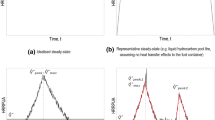Abstract
The directional flame thermometer (DFT) is a device used to measure radiative heat flux in fire scenarios. In many DFT applications, radiation is the dominant mode of heat transfer and convection does not significantly affect radiative heat flux predictions. However, at higher air velocities, neglecting convection causes error in heat flux predictions. This study explores the error caused by ignoring forced convection in heat flux predictions and proposes a method to reduce it. To accomplish this, a forward heat transfer model is used to generate synthetic temperature data for the DFT given radiative and convective conditions. Using the forward model and an existing inverse model, this study shows that assuming natural convection is the only mode of convective heat transfer leads to significant error in the predicted radiative heat flux. To reduce this error, this work proposes a framework for recovering the heat transfer coefficient and radiative heat flux in forced convection conditions. The framework utilizes an additional thermocouple above the plate of the DFT. The framework performed poorly for simulations in which the temperature of the air stream and that of the thermocouple was lower than 15\(^{\circ }\)C. Omitting simulations where this condition holds, on average, using the framework under constant heat flux and constant characteristic air velocity conditions reduces the error in the predicted heat flux by a factor of 12 compared to when the heat flux is predicted assuming that natural convection is the only mode of convection. A simple experimental test was conducted to validate the computational framework.
















Similar content being viewed by others
References
ASTM (2019) Standard test method for measuring heat flux using directional flame thermometers with advanced data analysis techniques. Tech. Rep., ASTM.
Cabrera J, Moser R, Ezekoye O (2020) A modified directional flame thermometer: development, calibration, and uncertainty quantification. J Verif Valid Uncertain Quantif 5(03):011003
Beck J (1999) User’s manual for ihcp1d: program for calculating surface flux from transient temperatures inside solids. Beck Engineering Consultants Co, Okemos, MI
Blackwell B, Douglass R, Wolf H (1990) Soddit. sandia one-dimensional direct and inverse thermal code. Tech. rep., Sandia National Labs, Albuquerque, NM
Lam C, Weckman E (2009) Steady-state heat flux measurements in radiative and mixed radiative-convective environments. Fire Mater Int J 33(7):303–321
Sultan M (2010) Comparisons of temperature and heat flux in furnaces controlled by different types of temperature sensors. In: Parker AJ (ed) Advances in the state of the art of fire testing. ASTM International, West Conshohocken
Keltner N, Beck J, Nakos J (2010) Using directional flame thermometers for measuring thermal exposure. J ASTM Int 7(2):1–12
Sultan M (2010) Performance of different temperature sensors in standard fire resistance test furnaces. Fire Technol 46(4):853–881
Philip K (2008) Modeling of directional flame thermometer for real-time incident radiation measurements in room fire testing. Master’s thesis, The University of Texas at Austin.
Kokel P, Weinschenk C, Ezekoye O (2010) Evaluation of directional flame thermometer for real-time inversion of heat flux. Int Heat Transf Conf 49392:83–92
Drysdale D (2011) An introduction to fire dynamics. Wiley, New York
Kutz M (2018) Handbook of environmental degradation of materials. William Andrew, Norwich
Whitaker S (1972) Forced convection heat transfer correlations for flow in pipes, past flat plates, single cylinders, single spheres, and for flow in packed beds and tube bundles. AIChE J 18(2):361–371
Kazemi M, Nobes D, Elliott J (2017) Effect of the thermocouple on measuring the temperature discontinuity at a liquid-vapor interface. Langmuir 33(28):7169–7180
Roberts I, Coney J, Gibbs B (2011) Estimation of radiation losses from sheathed thermocouples. Appl Therm Eng 31(14–15):2262–2270
Acknowledgements
This work is supported by U.S. National Science Foundation under Award No. 1707090.
Author information
Authors and Affiliations
Contributions
JIF: Methodology, software, formal analysis, visualization, writing—original draft. OAE: conceptualization, methodology, funding acquisition, supervision, writing—review and editing. JMC: conceptualization, methodology, writing—review and editing.
Corresponding author
Ethics declarations
Conflict of interest
The authors declare that they have no known competing financial interests or personal relationships that could have appeared to influence the work reported in this paper.
Additional information
Publisher's Note
Springer Nature remains neutral with regard to jurisdictional claims in published maps and institutional affiliations.
Rights and permissions
Springer Nature or its licensor (e.g. a society or other partner) holds exclusive rights to this article under a publishing agreement with the author(s) or other rightsholder(s); author self-archiving of the accepted manuscript version of this article is solely governed by the terms of such publishing agreement and applicable law.
About this article
Cite this article
Franqueville, J.I., Cabrera, JM. & Ezekoye, O.A. Improving Heat Flux Predictions for Directional Flame Thermometers by Incorporating Convective Effects. Fire Technol 58, 2463–2483 (2022). https://doi.org/10.1007/s10694-022-01263-w
Received:
Accepted:
Published:
Issue Date:
DOI: https://doi.org/10.1007/s10694-022-01263-w




